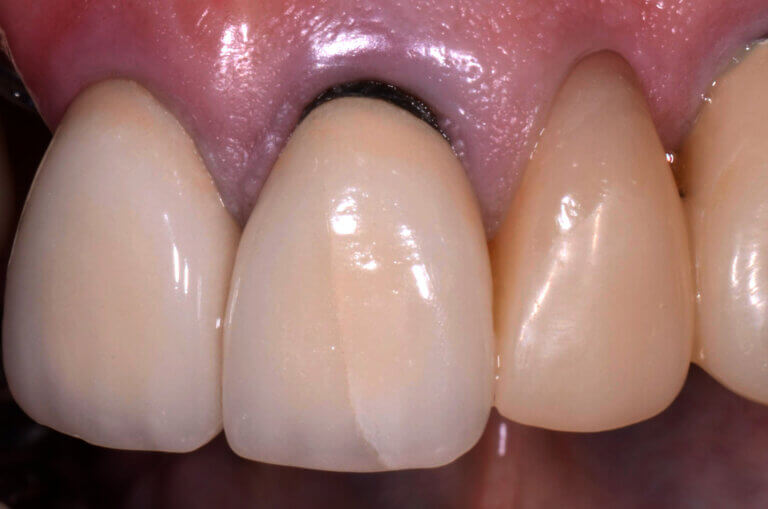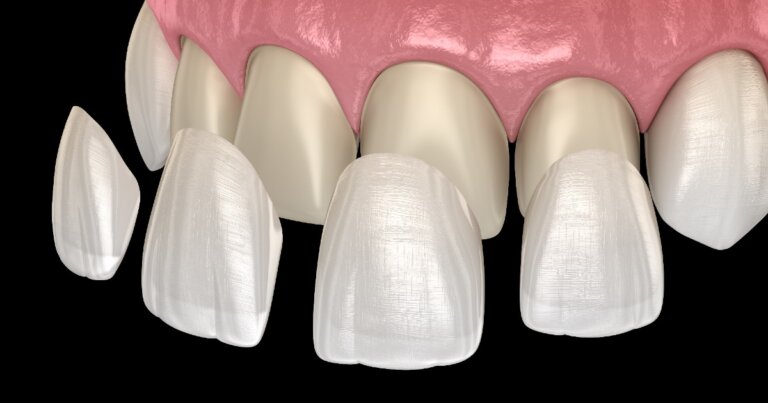A Cavity Under A Veneer

What Is A Cavity Under A Veneer?
A cavity under a veneer occurs when tooth decay develops beneath the veneer, which is a thin layer of porcelain or composite material bonded to the front of a tooth to enhance appearance. Veneers offer a minimally invasive solution for a perfect smile, but without proper care, bacteria and plaque can accumulate around the base, eventually leading to decay. Left untreated, cavities under veneers can cause tooth sensitivity, pain, and even infection, potentially leading to more severe dental issues.
Before you contact a Toronto dentist to examine A Cavity Under A Veneer, there are some things you should know as a patient:
- Why Do Cavities Form Under Veneers?
- Signs And Symptoms Of A Cavity Under A Veneer
- Treatment Options For A Cavity Under A Veneer
- Managing A Cavity Under A Veneer Until You Can See The Dentist
- Cavity Risk Self Quiz
- Frequently Asked Questions About Cavities Under a Veneer
If you have questions about A Cavity Under A Veneer or other dental problems, please contact us for more information.
Why Do Cavities Form Under Veneers?
Several factors contribute to the development of cavities under veneers:
- Poor Oral Hygiene: Not brushing or flossing regularly allows plaque and bacteria to build up, especially near the gum line, leading to decay.
- Aging Veneers: Over time, the bonding cement that holds veneers in place can weaken, allowing bacteria to seep in and cause decay.
- Wear and Tear: Veneers can chip or crack, creating spaces for bacteria to enter and lead to cavities.
- Improper Fit: If a veneer doesn’t fit properly, gaps or ledges may form where bacteria can accumulate and cause decay.
- Dietary Habits: High-sugar diets can feed harmful bacteria that produce acids, eroding enamel and leading to cavities.
Maintaining good oral hygiene and regular dental visits are key to preventing cavities under veneers. If you have further questions about A Cavity Under A Veneer, please contact us.
Signs And Symptoms Of A Cavity Under A Veneer
Detecting a cavity under a veneer early is crucial for effective treatment. Here are common signs and symptoms to watch for:
- Tooth Sensitivity: Pain or discomfort when eating or drinking something hot, cold, or sweet.
- Persistent Toothache: You may feel a dull or sharp pain, especially when biting down.
- Discomfort or Pressure: A feeling of pressure or unease around the affected tooth.
- Swollen Gums: Redness or swelling around the gum line near the veneer.
- Bad Breath: Foul odor or an unpleasant taste in your mouth that persists even after brushing.
If you notice any of these symptoms, schedule a dental appointment as soon as possible. Ignoring them can lead to more severe complications such as infections or even tooth loss. If you have further questions about A Cavity Under A Veneer, please contact us.
Treatment Options For A Cavity Under A Veneer
Depending on the severity of the decay, your dentist may suggest one or more of the following treatments:
- Veneer Replacement: If the cavity is extensive, the veneer may need to be removed and replaced.
- Dental Crown: If the decay has caused substantial damage to the tooth, a dental crown might be the best option. A crown covers the entire tooth, providing more protection than a veneer and restoring both function and appearance.
- Root Canal Therapy: If the decay has reached the tooth’s pulp, a root canal may be necessary to remove infected tissue.
- Filling or Bonding: For minor decay, your dentist can remove the cavity and seal it with a filling or bonding material.
The best treatment will depend on the extent of the decay. Contact your dentist to discuss the best course of action for your specific situation. If you have further questions about treatment options for A Cavity Under A Veneer, please contact us.

Managing A Cavity Under A Veneer Until You Can See The Dentist
If you suspect you have a cavity under a veneer but can’t see your dentist immediately, here’s what you can do in the meantime:
- Maintain Good Oral Hygiene: Brush and floss carefully around the veneer. Use warm salt water or mouthwash to help reduce bacteria and soothe any discomfort.
- Avoid Sugary and Acidic Foods: Steer clear of foods that could worsen the decay.
- Use Over-the-Counter Pain Relievers: Medications like ibuprofen (Advil) or acetaminophen (Tylenol) can help manage pain until you see your dentist. A combination of 1000mg acetaminophen and 600mg ibuprofen every 4-6 hours can be particularly effective for short-term relief.
While these measures can help manage discomfort, they are not a substitute for professional dental care. Contact your dentist as soon as possible for an appointment. If you have further questions about treatment options for A Cavity Under A Veneer, please contact us.
Cavity Risk Self Quiz
Try Our free online dental caries risk assessment quiz based on the California Dental Association’s Caries Management by Risk Assessment (CAMBRA) designed for patients aged 6 years and older. This caries risk assessment tool is meant to give you an idea of your level of dental caries risk, and by no means substitute for an oral exam by a dental professional. Please contact us for a more complete examination.
Frequently Asked Questions About Cavities Under a Veneer
- How can a cavity form under a veneer?
Cavities can develop if bacteria penetrate the bond between the veneer and the tooth. Poor oral hygiene, gum recession, or damage to the veneer can increase the risk.
- Can a cavity under a veneer be treated without removing the veneer?
In some cases, minor cavities at the edges of a veneer can be treated without removing it. However, extensive decay may require removing the veneer to properly address the issue.
- Does replacing a veneer with a cavity underneath damage the tooth?
If the cavity is treated promptly, the tooth can often be restored without significant damage. However, extensive decay may require more invasive treatments, such as a crown or root canal.
- Does having a veneer increase the risk of cavities?
Veneers themselves do not increase the risk, but poor oral hygiene or improper maintenance can lead to decay around or under them. Following your dentist’s care recommendations helps prevent this.
Cavities under veneers can compromise both the tooth and the veneer if not treated promptly, but early detection ensures effective care and restoration. Contact us for more information about cavities under veneers.

